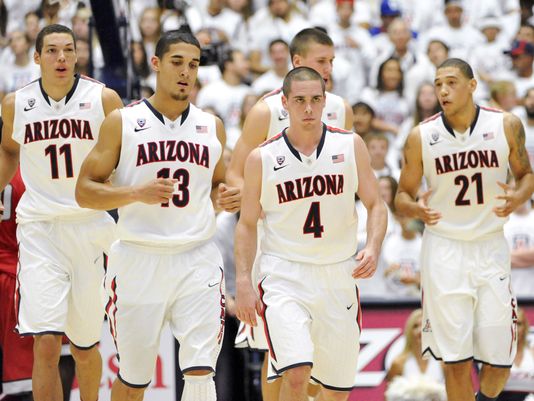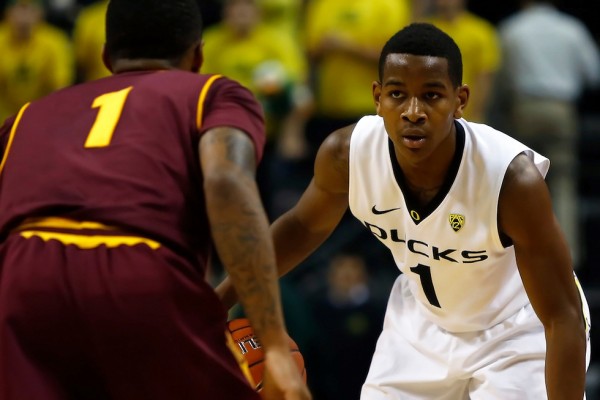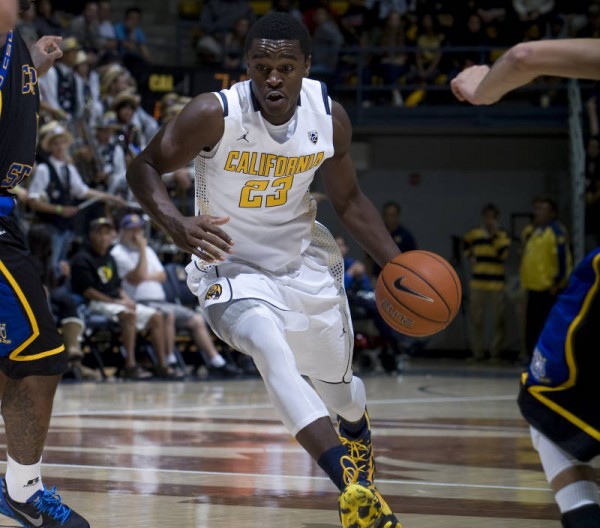Assessing the Pac-12 After One Month
Posted by Andrew Murawa (@AMurawa) on December 12th, 2013We’re a month into the season, something basically approaching the quarter-pole of this race, so it seems like a good time to take a look back at what’s happened so far, prognosticate a bit into the future, and reset the season as we move forward.
Overall, coming into the year, we regarded Arizona as the clear-cut favorite in the conference. A month in, the Wildcats have done nothing to dissuade us of that notion; in fact, if anything, they’re probably even a bigger favorite than they were in early November. Seeing the improvement the sophomores have made, the cohesiveness of this team defensively from the get-go, and contemplating the improvement that can still be made – especially on the offensive end – the ‘Cats remain the big boys in the Pac-12. That being said, Oregon, UCLA and Colorado have all established themselves as Top 25 caliber teams with plenty of upside. With the Wildcats needing to make road trips to visit every one of those teams, there will be plenty of chances for Arizona to slip up in conference play.

In The First Month, Arizona Has Solidified Its Reputation As The Pac-12 Favorites (Casey Sapio, USA Today Sports)
Beyond that group at the top, California sort of sits in a tier by itself; it would be a serious surprise if the Golden Bears compete for a conference title, but at the same time, it would be a stretch to picture this team on the outside looking in on Selection Sunday. However, after the Bears, there are plenty of question marks. Arizona State started off strong, but a couple of slip-ups in the Wooden Legacy damaged their early hopes. Stanford’s got plenty of talent, but this team has done little to give any but the most myopic Cardinal fan hopes of serious change. And while Utah has looked exciting at times, that is a team that is going to be up and down over the course of the year; yes, they may sneak up and bite unsuspecting visitors to Salt Lake City in the butt, but they’ll also turn in a couple stinkers of their own. Beyond that, however, USC, Washington, Washington State and Oregon State are a good bet to make up the bottom third of the standings come March. Below, we’ll take a look at each of those top eight teams and talk about what we’ve learned over the first month and what needs to change going forward.
- Arizona – The defense is dialed in, the entire seven-man rotation has offensive ratings at 106 or higher, and yet, there is still room for improvement. To begin with, while the Wildcats have made it a priority to get the ball into Kaleb Tarczewski with regularity in the post, and while he has finished well at times (he’s 31-of-55 from the field thus far), there have been instances when he has struggled, most notably in the second half against Duke. He’s been good, but he can be better. Likewise, Aaron Gordon, whose strength is finishing around the paint is shooting below 50 percent from two-point range. He can and should do better, but in part because the Wildcats have him playing the three, he is too often putting up more difficult mid-range jumpers.
- Oregon – While the Wildcats’ strength is on the defensive end, the Ducks are stellar offensively, ranked fourth in the nation in offensive efficiency. Joseph Young has been a revelation, Jonathan Loyd has been a rock at the point, and Mike Moser is beginning to look a whole lot more like the Moser from 2011-12 rather than the disappointing version of last year’s vintage. Defensively, there is plenty of room for improvement, and things will begin to get better next week when Dominic Artis and Ben Carter return from their nine-game suspensions. While Artis is a small guard, his defensive pressure is a game-changer. Coupled with Young’s ability to jump the passing lanes, an Artis/Young backcourt could be a nightmare for opposing offenses.

Dominic Artis Is On The Verge of Returning From Suspension, And Will Make The Undefeated Ducks Even Better (Mason Trinca, Daily Emerald)
- UCLA – The Bruins may not be on the same page as the Ducks, but they’re in the same chapter. UCLA’s offense is far ahead of its defense, but unlike the Ducks, UCLA doesn’t have any reinforcements on the way. If UCLA is going to improve its defensive performance, they’re going to have to do it with the same players they’ve been running out there so far. The biggest need for improvement comes along the front line where sophomore Tony Parker is significantly improved but still somewhat lacking; he needs to learn to play defense without fouling. Meanwhile, the Wear twins are off to a terrible start to their senior campaigns. Travis Wear missed time following an appendectomy, so he’s got something of an excuse, but the pair has taken noticeable steps backward thus far this season.
- Colorado – That loss to Baylor back on opening night was uninspiring at the time. Nowadays, with Baylor sitting at 8-1 with wins over Kentucky and Dayton, it looks a whole lot more understandable. Still, the Buffaloes had plenty of room for improvement following that loss. The good news is that they’ve made significant strides in that direction. Askia Booker has slumped early this year, but he may have a chance to ride his big shot against Kansas to better things, and Spencer Dinwiddie has taken a back seat in favor of getting more shots for his frontcourt guys. The Buffaloes still need to get Josh Scott the ball more often. Not only is he an accomplished post scorer, but he is a terrific passer from the blocks when the opposition chooses to double-team him. You still want Dinwiddie with the ball in his hands most often, but Scott using fewer than 20 percent of the Buffs’ possessions is too little.
- California – Mike Montgomery has been very displeased with his team’s defensive performance. Just this week, Tyrone Wallace and Jabari Bird were called out against Nevada, getting shifted out of their starting roles and brought off the bench in part because of their poor defensive intensity in a loss at UC Santa Barbara. So, how did the Golden Bears respond? Well, they gave up 1.23 points per possession to a not-very-good defensive team. On a team that isn’t really trying to force turnovers — instead choosing to pack it in and make opponents score over them — the Bears have been porous on the perimeter and less than great on the defensive glass. The best bet for improving their defensive output? Getting through to Wallace and Bird, two guys who have the athletic ability to become excellent perimeter defenders.

While Jabari Bird’s Offensive Skills Are Not In Dispute, His Head Coach Is Concerned About His Defensive Focus (GoldenBearSports.com)
- Arizona State – Aside from the Sun Devils’ unfortunate Thanksgiving weekend in Orange County, things have looked good. But really, what the hell happened there? They made a bad Creighton defense look like world-beaters, then turned around and lost to a bad Miami team in a game in which Jahii Carson played in a very Carson-unlike way. Offensively, this ASU team has more weapons this year than they did last, with Jermaine Marshall a potent three-point threat, Shaquielle McKissic an athletic slasher, and even Jordan Bachynski showing improvement. And, oh yeah, Carson has taken a step forward as well, cleaning up his jumper. And they’re very similar to what they were last year. So all those things indicate that this is an ASU team that should be in the NCAA Tournament. Yet somehow, they’re going to head into conference play with really only a win over Marquette in the solid column and that loss to Miami in the bad column. In other words: bubble alert!
- Stanford – The defense has been bad. Really bad. The Cardinal gave up 1.25 points per possession to BYU in a loss. It got worse against Pitt, to the tune of 1.33 PPP. Head coach Johnny Dawkins has tried to run a 2-3 zone on a regular basis, putting Chasson Randle and Anthony Brown up top with Josh Huestis, Dwight Powell and Stefan Nastic along the front line. In the process, he’s taken a team that wasn’t great to begin with on the defensive end and made it worse. With guys like Huestis, Powell, Brown and Randle, he’s got plenty of athletes who can check their guys one-on-one. Settling them back into the zone takes away some of their individual aggressiveness. Some of that may filter over to the offensive end, where Powell, in particular, has been far less aggressive this year than last year. This team is never going to be an elite defensive team, and that’s fine. But they can’t be bad as they are now. In the process, they’ve got to be very good offensively, something they’ve failed to achieve yet this year. Easy solution? Ditch the zone, except as a temporary change of pace.
- Utah – They’ve only played one team of consequence, and in that game they went to Boise State and lost by a deuce. But still, it is easy to get the feeling that this is a good, solid team. First off, did you know that this team has the best two-point field goal percentage in the nation? A lot of that has to do with junior point guard Delon Wright, who has not only made 53-of-68 from inside the arc (he’s also added four threes to that total on 11 attempts), but has done a terrific job of finding teammates for easy buckets. While the efficiency numbers will certainly dip as competition picks up, that kind of thing is going to continue. He’s a good athlete with a great feel for the game. As for what Utah can do to improve, let’s table that question until the Utes get to conference play and are regularly facing opponents that can expose their weaknesses.










































